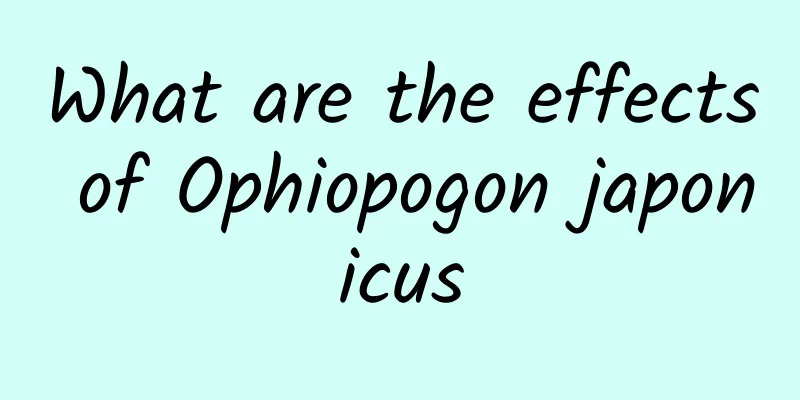What are the effects of Ophiopogon japonicus

|
I believe that everyone has a certain understanding of the medicinal value of Ophiopogon japonicus. Generally, the main way we consume Ophiopogon japonicus in our lives is by making soup and drinking it, because Ophiopogon japonicus is very helpful for us to treat summer heat and gastroenteritis. We hope that everyone can have a good understanding of the efficacy and value of Ophiopogon japonicus in life, which will be more helpful to you. 1. To treat summer sweating and collapse, use 10 grams each of Ophiopogon japonicus and ginseng, 6 grams of Schisandra chinensis, decocted in water, 2 doses per day. It is effective for sweating, collapse, palpitations, low blood pressure, excessive sweating, thirst, fatigue and weakness. 2. To treat intestinal constipation caused by dry intestines, take 15 grams each of Ophiopogon japonicus, Rehmannia glutinosa, and Scrophularia ningpoensis. Take it in decoction, 1 dose per day. It has the effect of moistening the intestines and promoting bowel movements, and is used for dry stools. 3. To treat angina pectoris caused by coronary heart disease, take 45 grams of Ophiopogon japonicus, add water and boil it into 30-40 ml, take it in divided doses, and take it for 3-18 months. It has a certain effect on relieving angina pectoris and chest tightness. 4. To treat chronic gastritis, take 9 grams each of Ophiopogon japonicus and Astragalus membranaceus, and 10 grams each of Codonopsis pilosula, Polygonatum odoratum, and Polygonatum sibiricum. Take it in decoction, 1 dose per day. It is effective for those with insufficient stomach yin. 5. To treat diabetes, use 30 grams of reed root, 15 grams of Ophiopogon japonicus, and 12 grams of Anemarrhena asphodeloides. First boil over low heat for 30 minutes, filter out the decoction, add 500 ml of water to the residue, bring to a boil over high heat, then simmer over low heat for 20 minutes, remove the residue and take the juice, mix the two decoctions and take one dose per day. It is used for diabetic patients with thirst, dry throat, polydipsia, restlessness, or low fever, red tongue, and thin and rapid pulse. 6. To treat acute and chronic bronchitis, take 9g each of Ophiopogon japonicus, Asparagus cochinchinensis, Anemarrhena asphodeloides, Fritillaria cirrhosa, and Stemona japonica, and 12g of Adenophora scabra. Take it in decoction, 1 dose per day. This prescription is suitable for patients with acute and chronic bronchitis presenting with yin deficiency and dry cough. The article tells us in detail what are the effects of Ophiopogon japonicus. I believe you all know that Ophiopogon japonicus is helpful for us to treat diseases such as coronary heart disease and chronic gastritis. Therefore, we suggest that you should make good use of the effects of Ophiopogon japonicus in your life. |
<<: What are the effects of Trachelospermum erythrorhizon
>>: What are the effects of Trachelospermum erythrorhizon
Recommend
The efficacy and function of wild nightshade
The medicinal value of wild solanum is beyond our...
The efficacy and function of breaking bowl flower
Many people know that the broken bowl flower has ...
How poisonous is this "poisonous bowl" that netizens are hotly discussing?
□ Science Times reporter Shi Qi Recently, the Wei...
World Health Day: Can’t give up the taste? “Sodium” is not a good idea! If you like strong flavors, you should reduce the amount of salt!
What are the difficulties in reducing salt intake...
What are the medicinal values of katydid?
I believe everyone is familiar with katydid, whic...
How to transform Mars into a second Earth?
Among the planets in the solar system, Mars is th...
The efficacy and function of ant flower root
As for Ant Flower Root, I think some people may h...
What kind of wash is there in the Chinese herbal hair care formula?
Using traditional Chinese medicine to nourish hai...
What are the effects of drinking Codonopsis and Astragalus in water?
Everyone knows that Codonopsis pilosula and Astra...
Can mugwort cure skin diseases?
Many people don’t know that mugwort can be used t...
Does each organ in the body have an aging timetable?
As we age, the functions of various organs in the...
It is said that a Chinese poet thousands of years ago "saw" the Earth from outer space...
The Mengtian Laboratory Cabin has recently become...
Aerial grabbers are cool? Bird: It was my claws that inspired you
If you like to visit parks, you must have seen bi...
Is it really necessary to clean barnacles from whales and turtles?
Recently, there have been many videos of people r...
Many breast cancers are discovered in the late stages. Is it really too late? You need to know these coping strategies!
Author: Song Guohong, Chief Physician, Peking Uni...









